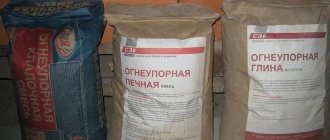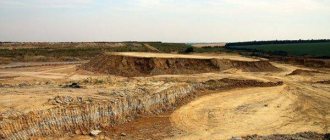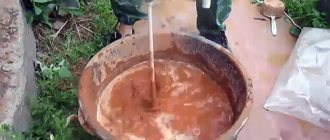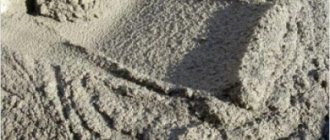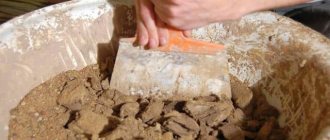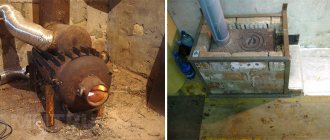Today, the construction of buildings can be made from various materials. New, cost-effective construction technologies from combined materials are gaining popularity, but despite all the new products, brick construction is considered the most reliable, and buildings are warmer and more durable.
An important element of brickwork is the mortar, which is used to create a durable structure from individual elements.
Requirements for mortar for bricklaying
The main requirements for the solution are the requirements for strength and durability.
Based on strength, solutions are marked from M4 to M200. Frost resistance - from F10 to F200.
Important!
In terms of strength, the solution must meet the requirements of the project, and in terms of durability - the operating conditions of the structure.
It is interesting that the strength of brickwork on fresh, unhardened mortar is 3 times less than the strength of the same masonry on hardened M100 grade mortar.
In addition to strength and durability, an important requirement is sufficient mobility of the solution and its moisture-holding capacity.
The point is not only that a mobile solution that is not prone to delamination is more convenient to work with and saves time, but also that such a solution compacts and fills the seams better, as a result of which the strength of the masonry can increase by 1.5–2 times .
What are the types of masonry mortars?
The main component in masonry mortar is the binder. Solutions can be prepared on the basis of cement, lime, clay, gypsum. In low-rise construction, as well as in cases where there is no need to use high-grade mortars, local binders are used, widely available in the region, for example, lime-slag or lime-ash cement.
Since each binder has its own advantages and disadvantages, complex mortars are also prepared using several types of binders, for example, cement-lime, cement-clay mortars.
In addition to the binder, the composition of the masonry mortar includes:
- sand,
- water,
- additives of mineral or chemical nature.
For brickwork, mortars mixed with sand with a maximum particle size of 2.5 mm are used.
Important!
The composition of the solution is selected depending on the following factors:
- bearing capacity of the structure,
- operating conditions of the product.
The solution recipe takes these factors into account and is selected depending on the selected type of binders and sands.
Main types of masonry mortars:
- cement;
- lime;
- cement-lime;
- cement-clay.
Features of the resulting mixture
Clay mortar has certain limits in its area of use. The hottest areas are the most suitable for use: combustion and heat-storing parts of the structure. This is explained by the fact that the resulting solution can withstand high temperatures and direct exposure to flame, but quickly becomes unusable when exposed to condensation or significant mechanical loads.
On a note! Due to its reliable adhesion, the clay composition can last for many years even under conditions of intensive use at temperatures up to 1000°C.
Clay mortar has been used for laying stoves since time immemorial.
Advantages:
- Environmentally friendly. All components are of natural origin and do not emit substances harmful to human health.
- Availability. The components can be obtained, prepared by hand, or purchased at a reasonable price.
- Easy to dismantle. If it becomes necessary to move or replace a section of the furnace, the work will not require significant effort. The mixture is easily removed, and the bricks remain clean and intact.
But obtaining the necessary positive properties will require serious effort and time.
Cement masonry mortar
The cement mortar is prepared on the basis of cement (Portland cement), which is a water-hardening binder. Cement forms a strong material in the presence of water through hydration reactions.
Typically, cement mortars are used where the structure is exposed to aggressive environments (including humidity). Foundations and plinths are always made with cement mortar.
The advantages of cement masonry mortars are:
- strength;
- durability;
- water resistance, frost resistance;
- resistance to the development of fungus and mold;
- no restrictions on use (can be used, for example, for structures that will be used in conditions of high humidity, exposure to low temperatures or aggressive environments);
- rapid strength gain, which is especially important in multi-story construction.
Among the disadvantages of cement mortars are their high specific gravity, rigidity, and low mobility, which affects not only ease of use, but also how well the work will be carried out and, ultimately, how durable the structure will be.
To make the cement mortar more mobile and workable without adding excess water (which entails a loss of strength), plasticizing additives are used.
Important!
The depth of immersion of the cone in cement mortars for brickwork is from 9 to 13 cm.
The cheapest additives of this kind are slaked lime and clay. But their use is not always convenient. The lime must be slaked, that is, mixed with water and left for several days while the reaction occurs. Clay must have certain characteristics.
Special plasticizing additives are very convenient to use, for example, CemStone, which completely replaces clay and lime in cement masonry mortars. The supplement is laboratory tested and comes with clear instructions for dosing and use. It provides masonry mortars with all the necessary properties:
- increases the “lifetime” of the solution (up to 5 hours), thus allowing you to mix it in large quantities at once and save time or order it at a mortar unit;
- eliminates the delamination of the solution, as a result of which it does not require constant stirring;
- increases the efficiency of cement, allowing the use of even stale cement;
- does not cause corrosion of metal embedded parts and fittings;
- reduces the time for full strength gain (7 days instead of 28 days, which is required for a solution without additives);
- gives the solution increased characteristics of water resistance and frost resistance.
Hardening of the cement mortar occurs within 28 days, after which the mortar gains its design strength. The strength gain does not occur linearly: the fastest rate of hardening is observed immediately after laying the mortar, then it gradually slows down. Therefore, the more time has passed, the less adverse external influences affect the hardening process.
Adverse effects include too high or too low ambient temperatures and low air humidity. The optimal air temperature is +18–22° C and almost one hundred percent humidity.
Important!
The lower the ambient temperature, the slower the rate of strength gain, as can be seen in the table. At temperatures below +5°C, strength growth stops. Subsequently, when the air temperature rises, the solution gains strength, but is less durable than when cured under optimal conditions.
Obviously, it is impossible to avoid the work of laying bricks at low and subzero temperatures, because in this case it would be necessary to postpone construction for several months, which is not economically feasible.
In these conditions, masonry work can be carried out without compromising the strength of the structure if you use anti-frost additives, for example, CemFrio and HotIce from CEMMIX, which not only allow you to work at negative temperatures (down to –20°C), but also have plasticizer properties, as well as provide the following benefits:
- saving cement up to 10% without loss of strength;
- increasing the mobility of the solution;
- elimination of solution delamination during transportation and storage.
Additives CemFrio and HotIce are compatible with any type of cement and are safe for humans.
Fat content of clay
In order for the solution for stoves and fireplaces to be of high quality, before mixing it, it is necessary to determine the degree of plasticity of the clay, which directly affects the proportions of the components of the masonry mixture and the strength of the finished structure.
To check the fat content of clay, the following technology is used:
- Clay for the fireplace is kneaded to a stiff dough and kneaded. A ball with a diameter of about 5 cm is created from the finished mass, which is subsequently clamped using two planks. The planks need to be gradually compressed, observing how the formed ball behaves.
- Material of the right consistency begins to crack when the planks compress it to a third of its thickness. If cracks appear earlier, then the clay is too thin, and the opposite picture indicates increased fat content of the material.
Lime mortar for masonry
Our distant ancestors used lime masonry mortars to erect magnificent buildings that have stood for centuries and are still standing.
The fact is that slaked lime, an air-curing binder, gains strength in air, and this process continues for a long time. Even after years, such a solution continues to gain strength.
But for construction work, such a slow increase in strength is rather a disadvantage, because we want to get a strong structure not in 100 years, but in a few weeks. The use of lime masonry mortars in multi-story construction is especially inconvenient, since you have to wait a long time before starting the construction of the next floor.
The advantages of lime mortars include their low thermal conductivity, good plasticity, and high hygienic properties (they “breathe”). However, they are quite fragile and unstable to high humidity.
They are used only for masonry that is located above ground level and is not in contact with the ground.
Cement-lime masonry mortars
Cement-lime mortars are prepared from cement, sand and lime paste with the addition of water.
As a result, we obtain a solution that is more plastic than cement (since lime works as a plasticizer) and more durable, waterproof, and resistant to fungus than lime. Cement-lime mortars are also frost-resistant.
The proportions of cement and lime in solutions may be different; Depending on the formulation, such solutions can be used for both above-ground and underground parts of buildings.
Important!
In cement-lime mortars, plasticizers are also used to reduce the consumption of cement and lime.
We recommend studying: Plasticizers
Lime based
To prepare the mortar and build the base for the chimney, it is advisable to use a composition with lime and cement. It is important to properly mix quicklime and water in proportions of 3:1. The result is a finished dough, to which sifted sand is added, passing through a fine-mesh sieve, in the proportion of 3 parts sand to 1 part dough. After which the mass is diluted with clean water to obtain a thick consistency.
As a result, it is possible to obtain something strong and flexible enough so that it can be laid normally and serve for at least 10 years. The percentage of fat content can be changed by adding sand. If the mass is too greasy, add 5 parts of sand, and for a normal mass, add 3 or less parts.
Cement will help increase the strength of the solution. For production you need to mix 1 volume of dough with 5 volumes of sand and 0.5 cement. The methods for manufacturing the fastening composition have a similar sequence: the components are mixed in a special container.
The resulting dough must be mixed with an uncontaminated liquid until a dense consistency is obtained.
Cement-clay masonry mortars
Cement-clay masonry mortars are stronger than cement-lime mortars and set faster. Typically, in such solutions, cement is mixed with finely ground clay in various proportions, and the solution also includes sand and water.
Due to the fact that clay retains water well, this solution can also be used at low temperatures.
Important!
Masonry mortars, depending on the composition, may have special properties, for example, they can be heat-insulating, heat-resistant or decorative, colored, allowing to achieve an aesthetic effect.
Watch the video: Laying bricks with Perel colored mortar
Methods for improving loamy soil
Plants on heavy clay soil develop poorly, often get sick, or die from lack of nutrition. To create the necessary conditions for growing garden and vegetable crops, you need to improve the soil - make it looser, more airy and moisture-permeable.
By changing the listed qualities, you will also change the composition of the soil, since it will begin to warm up faster and will quickly become populated with various microorganisms. Let's look at methods that will help improve the composition of loamy soil.
Adding coarse river sand
Sand of fraction 2-4 mm is considered coarse-grained. It must be added regularly and in fairly large quantities (1 bucket of sand per 1 sq. m.).
Since it is necessary to “dilute” clay soil not only on the surface. The area to be improved must be periodically dug up so that the sand gradually penetrates into the deeper layers of the soil, which will also increase its aeration and warming. In virgin lands, clay soil is dug up 3-4 times per season.
In the future, this must be done every year, otherwise the sand will begin to exfoliate on the surface, and moisture will leave through it, but not penetrate deeper. With each year of mulching loamy soil with sand and surface loosening, the fertile layer of soil will increase.
Application of organic fertilizers
Living microorganisms will increase soil fertility. Therefore, organic matter is added to the mulched and dug clay soil. It is best to do this in late autumn, but it can also be done in early spring, when the snow has just melted and the soil becomes available for digging.
Suitable for beautification:
- large peat;
- manure;
- compost.
Peat is applied once every 4 years. It can be of different acidity, which will affect soil performance. And this must be taken into account when choosing peat - by studying the current soil pH and their compatibility with the plants that will be planted on it.
If the crops you grow love acidic soil, it is better not to add manure at all, as it has an alkalizing effect. Then use plant-based compost.
If you apply manure, choose horse or sheep manure. It is dug up, mixed with the top layer of soil. This should be done in the fall so as not to burn the roots of the plants in the spring.
You need to dig up fertilized soil regularly. This will ensure the looseness of the soil and the uniform distribution of microorganisms in it. You can simultaneously add sand and organic matter to improve clay soil.
Planting green manure
Growing green manure on loamy acidic soil will allow it to be structured, fertilized and will have a beneficial effect on the development of beneficial microflora. The following crops are suitable for sowing on loam:
- rye;
- phacelia;
- sweet clover;
- lupine;
- alfalfa;
- white mustard.
These green manures will improve the health of the soil and help deoxidize it a little. Also, corn stalks and leaves are used to refine loams. The coarse fibers of this plant take a long time to decompose in the soil and have a positive effect on its breathability and looseness.
Recipes for masonry mortars
The solution recipe is selected depending on the desired characteristics and is determined by the design documentation.
One of the most common cement mortars in construction, grade M100, for brickwork includes (per 1m3):
- cement – 250 kg;
- sand – 1580 kg;
- water – 140 l;
- CemStone additive – 1.25 l.
Solutions of different brands are used for different types of structures. Grades M150 and M200 are used for hydraulic structures.
How to mix masonry mortar with your own hands
Unlike large-scale construction, for which masonry mortars are ordered from mortar units, in private construction they often prefer to mix the mortars themselves.
Construction mixers and concrete mixers are used to mix solutions. In this case, it is especially important to use plasticizers in order to achieve an ideal solution and, if possible, eliminate shortcomings.
The order in which the components are mixed may vary. Some craftsmen mix dry ingredients and add water to them, others first pour water into a concrete mixer, then add sand to the water and only then cement. Lime dough is mixed with water to obtain lime milk, then it is used instead of water.
One of the mistakes when mixing masonry mortars with your own hands is adding detergents to them instead of a plasticizer. Since the exact composition and recipe of liquid soap are not known to us, we, in fact, do not know what we are adding to the solution and how this will affect the strength of the future structure. Adding a plasticizer in this case is the right step, which leads to predictably good consequences.
Useful video
Watch a video that tells you how to properly mix cement mortar: what to use for this, procedure, proportions.
Table of contents:
The quality of the furnace’s masonry, its tightness, heat resistance, and strength over the years depend on a properly mixed solution. A shortage or excess of any component leads to its cracking, loss of integrity, and carbon monoxide leakage. Ceramic bricks are used for the work, and it is the clay mortar for laying the stove that is homogeneous in composition. It provides a unified structure of the structure with the same physical properties of mortar and brick. That is why clay solution is considered the best.
How much solution will be needed
Before starting construction work, it is necessary to carefully calculate how much materials will be required. The consumption of mortar for brickwork is calculated per 1 m2 and also depends on the thickness of the brick and the thickness of the walls in the bricks. It can be viewed in the table.
Based on the required amount of solution, you can calculate the amount of necessary consumables.
We advise you to study: For plastering and masonry work
Specifications
Each subgroup of clays differs in the values of porosity, mineralization of pore water, capacity of the exchange complex, volumetric and specific gravity, thermal conductivity, and so on, since these indicators directly depend on the size of the particles of the material, as well as on their chemical and mineral composition. Table of specific gravity indicators for different types of clay:
The thermal conductivity of wet raw materials ranges from 0.4 to 3.0 W/(m K), and of dry raw materials - 0.1 ÷ 0.3 W/(m K).
Clay Density
For clay, as a rule, bulk density is indicated, real, technological and conditional (it is determined in laboratory conditions). Moreover, the conditional one always significantly exceeds the real one. Density is calculated by dividing the mass of a body by the volume it occupies. In the SI system, density is measured in kg/m², and in the GHS system in g/cm³. The density of wet clay ranges from 1600 to 1820 kg/m², and the density of dry clay ranges up to 1000 kg/m³.
One of the technical indicators of a plastic material (as well as other bulk substances) is the compaction coefficient, which is determined by the ratio of the actual bulk density to the volume of normally compacted material located at a certain depth (the dependence of the density of clay on the depth of its occurrence has been experimentally proven). The density is considered normal if this ratio is equal to one; if less than 1, then the rock is not compacted enough.
